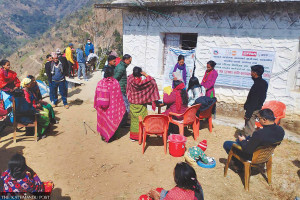 19.12°C Kathmandu
19.12°C KathmanduColumns
No tiger for breakfast
The Ranas used tiger hunting to appease and renew their friendship with the British in India.
Abhi Subedi
A visit to the wilds of Assam and Arunachal states in India last week reconfirmed my perception of the changing nature of ecological dynamism and activism. I was thrilled and stunned to meet some individuals and visit Kaziranga National Park and Pakke Tiger Reserve, among others. The visit was partly literary and partly related to my ecological interests. It reminded me of the familiar experiences of my visits to Bardia and Chitwan National Parks in Nepal. I want to begin with the Nepali history of the grand theme of nature and the human sense of conquering it to show how that is becoming an antiquated theme.
I allude to Michel Peissel’s book Tiger For Breakfast: The Story of Boris of Kathmandu (2019 ed.) as a metaphor for the grandiose nature of the theme of hunting and the exhibition of human power over animals. The book's protagonist, Boris Lissanevitch, is a famous ballet dancer and night-club king who goes hunting with film stars and maharajas. His history had already begun by 1960. The Royal Hotel is another metaphor. The cover photo shows Boris squatting and holding a gun by the dead body of a huge tiger as a mark of his prowess as a hunter. A fine lady sits beside him, not exuding any pride. I had met Boris’s widow, a senior and elegant woman, through my British friend and linguist, the late Lindsay Friedman.
The British, who came hither as colonial rulers, likened hunting animals to male pride. However, they were not doing anything new by hunting; rather, they were imitating the Maharajas of India, who did shikar by killing abundant animals until their numbers dwindled. The British made hunting a sport, which was an outdoor system for them. The Wildlife Protection Act of 1972 made hunting illegal in India.
The concept of hunting as a male royal game and a way of showing bravado was popular among the Rana and Shah rulers. They even invited the British to visit Nepal for hunting. The killing of animals was part of diplomacy, as the rulers used tiger hunting to appease and renew their friendship with the British rulers. The Ranas did know how to play with the psyche of the colonial rulers and their representatives in India.
“Battis salko rojanamcha”, or Jung Bahadur's diary of 1875, includes a few lines about hunting in Nepal. I translate some lines about the visits of some British dignitaries for hunting at the invitation of the Rana ruler. They describe a cruel scene like this: “After the prince killed six tigers, other princes present there could not resist the temptation. After Captain Carrington opened the first fire at one tiger, five or seven other princes opened fire and killed that tiger.” Apparently, several people killed the injured tiger, which looks so brutal.
I want to mention another short text about hunting with British high-class visitors. An erstwhile senior official of the Royal Palace gave me a slim booklet titled Some Notes on Shikar in Nepal, written by Field Marshal Kaiser Shumsher Jung Bahadur Rana. He describes very historical Nepali-English hunting from the same period as mentioned above. The booklet says, "His Royal Highness the Duke of Edinburgh, second son of Her Majesty Queen Victoria, came for a shoot in the forests of the Nepalese Terai—23rd February to 28th February 1870. HRH bagged two tigers measuring ten feet six inches and ten feet three inches. The forests were dense and deer plentiful”.
Rana has described another hunting expedition in 1990. In this eloquent expression, the use of language is very notable; it shows the hunter's pride and bravado. Rana's description of hunting speaks volumes about the nature of hunting and the pride of the hunter. He says, “Prince Albert bagged six tigers in Western Nepal. King George the Fifth shot in 'Chitone’ from 16th to 28 December 1911." The following lines are even more eloquent: "The king and his suite bagged thirty-nine tigers, eighteen rhinos and one bear”. This looks like animal carnage. Admiring the hunting skill of the monarch, Rana says, “King George’s prowess with his rifle was considered by old Nepalese Shikaris as more wonderful than those of the Earl de Grey in 1883, HRH the Duke of Orleans in 1888 and HIH Archduke Franz Ferdinand in 1893."
My Assam experience has evoked a current sense of harmony, preservation and ecological activities. Going to Kaziranga National Park was a thrilling experience. This park represents a state-level act of reservation and preservation. However, meeting individuals and getting familiar with their work was a very moving experience.
The meeting with Manoj Gogoi, a dedicated naturalist and conservationist in Assam's Kaziranga National Park, was amazing. Gogoi has rescued over 6,000 injured wild animals, including snakes and birds. Gogoi is a crusader who has involved over 100 local youths in wildlife rescues and training camps.
During my visit, I also met Nandini Velho, who, after a PhD in Australia and a post-doc from the United States of America, chose the wilds of this region, mainly the Pakke Tiger Reserve, to do her research. She is actively engaged with the remote tropics of northeastern India, challenging traditional disciplinary boundaries, and has done 12 years of groundwork. She has founded Canopy Collective at Green Hub to bridge the gap between scientific research and on-the-ground initiatives.
Meeting Neelam Dutta, an organic farmer, was equally liberating. I thought he was a mystic in his total faith in the rhythm and vision of nature. But he is also a realist with over two decades of hands-on experience in organic farming. It was pleasant to meet Dutta’s crowd working in the mystic but realistic dreamscape.
I felt energised by visiting Assam and meeting simple but powerful young people working with the energy of saviours and creators. In Nepal, too, the youth and creative people have been developing similar synergy for work. This trip made me revisit the Nepali hegemon that links nature and power, as represented by the “tiger for breakfast” metaphor. At present, the metaphor has become antiquated and should be abandoned.



















